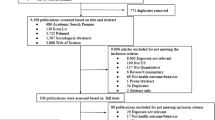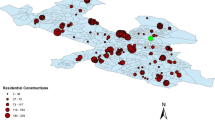Abstract
Recent studies have highlighted the role of geography and institutions as key determinants of urban development. In this paper, we test this hypothesis by considering the case of Italian cities over a very long time period, i.e., from 1300 to 1861. Our measure of development is the urban population, and we relate it to geographical and institutional variables at both city and regional level. We find that the quality of institutions as measured by the experience of free city-state and the presence of a university has a positive effect on urban development, whereas we could not find a robust impact of the quality of regional government. However, we also find that cities located in mountain areas grew less than cities located in lowlands, possibly with access to the sea. We interpret these results as evidence of the importance of urban institutions and geography in shaping urban development.
Similar content being viewed by others
References
Acemoglu D, Johnson S, Robinson JA (2001) The colonial origins of comparative development: an empirical investigation. Am Econ Rev 91(5): 1369–1401
Acemoglu D, Johnson S, Robinson JA (2002) Reversal of fortune: geography and institutions in the making of the modern world income distribution. Quart J Econ 117(4): 1231–1294
Acemoglu D, Johnson S, Robinson JA (2005) The rise of Europe: Atlantic trade, institutional change and growth. Am Econ Rev 95: 546–579
Alfani G (2008) Tono istituzionale e migrazioni urbane: il ruolo dell’acquisto o della perdita dello status di capitale nelle dinamiche demografiche delle città italiane. In: Sori E, Treves A (eds) L’Italia in movimento: due secoli di migrazioni (XIX–XX). Forum, Udine
Alonso W (1964) Location and land use. Harvard University Press, Cambridge
Ascheri M (1994) Istituzioni medievali. il Mulino, Bologna
Ascheri M (2006) Le Città-Stato. il Mulino, Bologna
Bairoch P (1988) Cities and economic development: from the dawn of history to the present. University of Chicago Press, Chicago
Barraclough G, Stone N (1989) Atlas of world history. Times Books, New York
Black D, Henderson JV (2003) Urban evolution in the USA. J Econ Geogr 3: 343–373
Bosker M, Brakman S, Garretsen H, de Jong H, Schramm M (2008) Ports, plagues and politics: explaining Italian city growth 1300–1861. Eur Rev Econ Hist 12: 97–131
Braudel F (1984) Capitalism and material life, 1400–1800. Fontana Collins, London
Cantoni D, Yuchtman N (2010) Medieval Universities, Legal Institutions, and the Commercial Revolution. Harvard University, mimeo
Cipolla CM (1965) Guns and sails in the early phase of European expansion, 1400–1700. Collins Sons & Co., London
Cipolla CM (1974) Storia Economica dell’Europa Pre-Industriale. il Mulino, Bologna
DeLong JB, Shleifer A (1993) Princes and merchants: European city growth before the indsutrial revolution. J Law Econ 36(4): 671–702
De Vries J (1984) European Urbanization 1500–1800. Methuen & Co, London
Diamond J (1997) Guns, germs and steeel: the fate of human societies. W.W. Norton & Co., New York, NY
Dobkins LH, Ioannides YM (2001) Spatial interactions among US cities: 1900–1990. Reg Sci Urban Econ 31: 701–732
Du Jourdin M (1993) L’Europe et la Mer. Editions du Seuil, Paris
Duranton G (1998) Labor specialization, transports costs and city size. J Reg Sci 38(4): 553–575
Eaton J, Eckstein Z (1997) Cities and growth: evidence from France and Japan. Reg Sci Urban Econ 27 443: 443–474
Fujita A, Mori T (1996) The role of ports in the making of major cities: self-agglomeration and hub-effect. J Dev Econ 49: 93–120
Gabaix X, Ioannides YM (2005) The evolution of city size distributions. In: Henderson JV, Thisse J-F (eds) Handbook of urban and regional economics, North Holland
Gallup JL, Sachs JD, Mellinger A (1999) Geography and economic development. Int Reg Sci Rev 22(2): 179–232
Guiso L, Sapienza P, Zingales L (2007) Lung term persistence. Northwestern University, mimeo
enderson JV, Wang HG (2006) Urbanization and city growth: the role of institutions. Brown University, mimeo
Ioannides YM, Overman HG (2003) Zipf’s law for cities: an empirical examination. Reg Sci Urban Econ 33(1): 127–137
Krugman P (1996) Confronting the mystery of urban hierarchy. J Jpn Int Econ 10(4): 399–418
Lamorgese (2000) Death and birth of a city: the myth of the (Arabian) phoenix. Temi di ricerca dell’Ente Einaudi, N. 15
Malanima P (1998) Italian cities 1300–1861: a quantitative approach. Rivista di Storia Econ 14(2): 91–126
Malanima P (2005) Urbanisation and the Italian economy during the last millennium. Eur Econ Hist Rev 9: 97–122
Martin R, Sunley P (2006) Path dependence and regional economic evolution. J Econ Geogr 6(4): 395–437
McArthur JW, Sachs JD (2000) Institutions and geography: comment on Acemoglu, Johnson and Robinson (2000), NBER Working Paper 8114
Milani G (2005) I Comuni italiani. Editori Laterza, Bari
Mills E (1967) An aggregative model of resource allocation in a metropolitan area. Am Econ Rev 57(2): 197–210
Muth R (1969) Cities and housing. University of Chicago Press, Chicago
North D (1981) Structure and change in economic history. Norton, New York
Percoco M (2010a) Path depedence, institutions and the density of economic activities: evidence from Italian cities. Università Bocconi, Milan
Percoco M (2010b) Entrepreneurship, social capital and institutions. Università Bocconi, mimeo
Percoco M (2011) Path dependence, institutions and the density of economic activities: evidence from Italian cities. Università Bocconi, mimeo
Pierson P (2000) Increasing returns, path dependence, and the study of politics. Am Polit Sci Rev 94(2): 251–267
Pirenne H (1925) Medieval cities, their origins and the revival of trade. Princeton University Press, Princeton
Putnam R (1993) Making democracy work. Princeton University Press, Princeton
Rossi-Hansberg E, Wright ML (2007) Urban structure and growth. Rev Econ Stud 74: 597–624
Sachs J (2001) Tropical Underdevelopment, NBER Working Paper N. 8119
Semykina A, Wooldridge JW (2005) Estimating panel data models in the presence of endogeneity and selection: theory and application. Michigan State University, mimeo
Tabellini G (2008) Culture and institutions in European regions. J Eur Econ Assoc (forthcoming)




